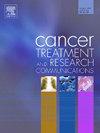PARP inhibitors as therapy for small cell lung carcinoma: A systematic review and meta-analysis of clinical trials
Q3 Medicine
引用次数: 0
Abstract
Background
Small Cell Lung Cancer (SCLC) is a neuroendocrine carcinoma characterized by aggressive behavior and poor prognosis with limited treatment options. Poly ADP-Ribose Polymerase inhibitors (PARPi) are novel anti-cancer agents that induce DNA damages and cause cell death in tumor cells with impaired DNA repair, known as the synthetic lethality concept. This study aimed to analyze the efficacy and safety of PARPi for patients with SCLC from available clinical trial data.
Methods
Studies reporting efficacy and safety of PARPi therapy for SCLC patients were searched across five databases with predetermined eligibility criteria in accordance with the PRISMA statement. Critical appraisal was done using suitable tools, outcomes were extracted, and analyzed.
Results
Five randomized controlled clinical trials with 451 interventional patients and 308 control patients with SCLC were included. The analysis showed increased Progression-Free Survival (PFS) (RR 0.92 (95 %CI 0.84–1.00; p=0.05)) and Objective Response Rate (ORR) (RR 1.27 (95 %CI 1.07–1.50; p=0.007)), no significant difference in Overall Survival (OS) (RR 1.03 (95 %CI 0.92–1.15; p=0.60)), and an increased risk for serious Treatment Emergent Adverse Events (TEAEs) (RR 1.13 (95 %CI 0.95–1.35; p=0.16)) in PARPi-receiving SCLC patients. Amongst the hematologic toxicities, sub-analysis showed that thrombocytopenia had the highest risk, followed by neutropenia, anemia, leukopenia, and lymphopenia.
Conclusion
The addition of PARPi in the chemotherapy regimen for patients with SCLC results in increased PFS and ORR, with no difference in OS and an increased risk of TEAEs. Further and larger clinical studies are needed to validate the efficacy and safety of PARPi therapy for SCLC patients.
求助全文
约1分钟内获得全文
求助全文
来源期刊

Cancer treatment and research communications
Medicine-Oncology
CiteScore
4.30
自引率
0.00%
发文量
148
审稿时长
56 days
期刊介绍:
Cancer Treatment and Research Communications is an international peer-reviewed publication dedicated to providing comprehensive basic, translational, and clinical oncology research. The journal is devoted to articles on detection, diagnosis, prevention, policy, and treatment of cancer and provides a global forum for the nurturing and development of future generations of oncology scientists. Cancer Treatment and Research Communications publishes comprehensive reviews and original studies describing various aspects of basic through clinical research of all tumor types. The journal also accepts clinical studies in oncology, with an emphasis on prospective early phase clinical trials. Specific areas of interest include basic, translational, and clinical research and mechanistic approaches; cancer biology; molecular carcinogenesis; genetics and genomics; stem cell and developmental biology; immunology; molecular and cellular oncology; systems biology; drug sensitivity and resistance; gene and antisense therapy; pathology, markers, and prognostic indicators; chemoprevention strategies; multimodality therapy; cancer policy; and integration of various approaches. Our mission is to be the premier source of relevant information through promoting excellence in research and facilitating the timely translation of that science to health care and clinical practice.
 求助内容:
求助内容: 应助结果提醒方式:
应助结果提醒方式:


